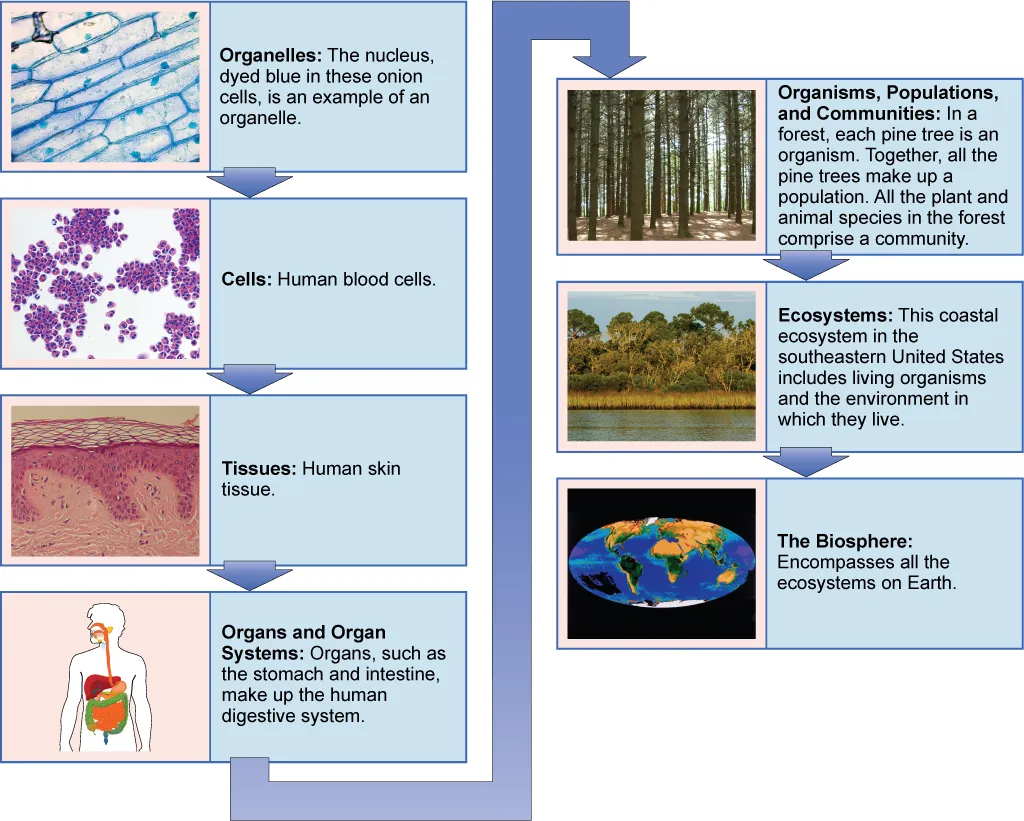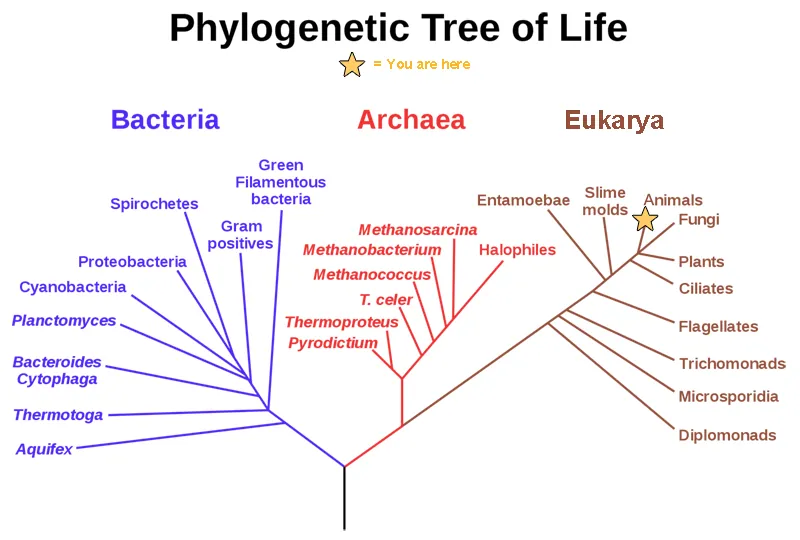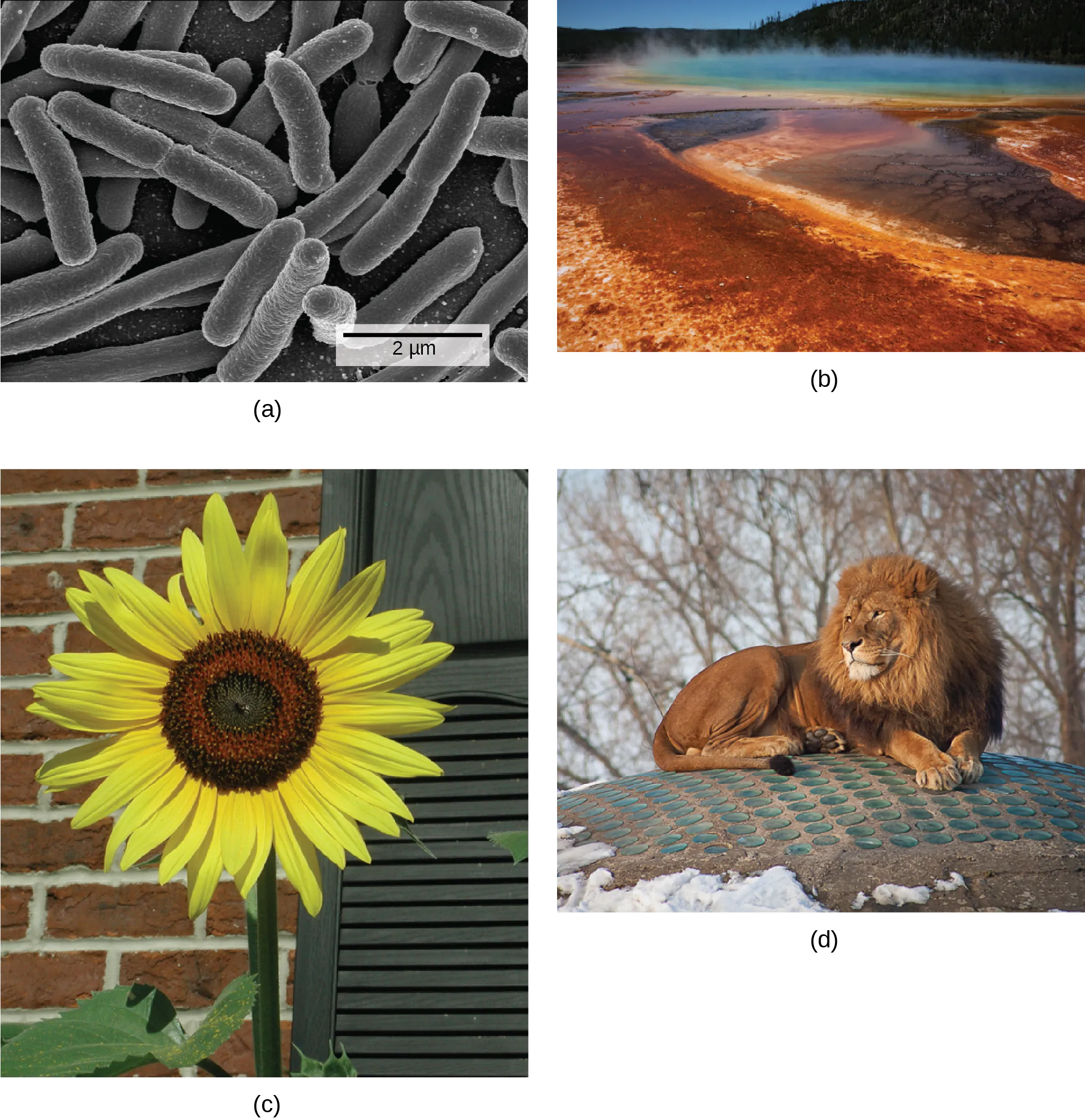3 Biological Organization and Diversity
Learning Objectives
After exploring this chapter, you should be able to
- Describe the levels of organization among living things
- Observe and describe examples of biological variation in a population of organisms.
- Differentiate between individual-level traits and population-level patterns.
Levels of Organization of Living Things
Living things are highly organized and structured, following a hierarchy that we can examine on a scale from small to large. The atom is the smallest and most fundamental unit of matter that retains the properties of an element. It consists of a nucleus surrounded by electrons. Atoms form molecules. A molecule is a chemical structure consisting of at least two atoms held together by one or more chemical bonds. Many molecules that are biologically important are macromolecules, large molecules that are typically formed by polymerization (a polymer is a large molecule that is made by combining smaller units called monomers, which are simpler than macromolecules). An example of a macromolecule is deoxyribonucleic acid (DNA) (Figure 1), which contains the instructions for the structure and functioning of all living organisms.

Some cells contain aggregates of macromolecules surrounded by membranes. We call these organelles. Organelles are small structures that exist within cells. Examples of organelles include mitochondria and chloroplasts, which carry out indispensable functions: mitochondria process energy to power the cell, while chloroplasts enable green plants to utilize the energy in sunlight to make sugars. All living things are made of cells. The cell itself is the smallest fundamental unit of structure and function in living organisms. (This requirement is why scientists do not consider viruses living: they are not made of cells. To make new viruses, they have to invade and hijack the reproductive mechanism of a living cell. Only then can they obtain the materials they need to reproduce.) Some organisms consist of a single cell and others are multicellular. Scientists classify cells as prokaryotic or eukaryotic. Prokaryotes are single-celled or colonial organisms that do not have membrane-bound nuclei. In contrast, the cells of eukaryotes do have membrane-bound organelles and a membrane-bound nucleus.
In larger organisms, cells combine to make tissues, which are groups of similar cells carrying out similar or related functions. Organs are collections of tissues grouped together performing a common function. Organs are present not only in animals but also in plants. An organ system is a higher level of organization that consists of functionally related organs. Mammals have many organ systems. For instance, the circulatory system transports blood through the body and to and from the lungs. It includes organs such as the heart and blood vessels. Organisms are individual living entities. For example, each tree in a forest is an organism. Single-celled prokaryotes and single-celled eukaryotes are also organisms, which biologists typically call microorganisms.
Biologists collectively call all the individuals of a species living within a specific area a population. For example, a forest may include many pine trees, which represent the population of pine trees in this forest. Different populations may live in the same specific area. For example, the forest with the pine trees includes populations of flowering plants, insects, and microbial populations. A community is the sum of populations inhabiting a particular area. For instance, all of the trees, flowers, insects, and other populations in a forest form the forest’s community. The forest itself is an ecosystem. An ecosystem consists of all the living things in a particular area together with the abiotic, nonliving parts of that environment such as nitrogen in the soil or rain water. At the highest level of organization (Figure 2), the biosphere is the collection of all ecosystems, and it represents the zones of life on Earth. It includes land, water, and even the atmosphere to a certain extent.

The Diversity of Life
The fact that biology, as a science, has such a broad scope has to do with the tremendous diversity of life on earth. The source of this diversity is evolution, the process of gradual change in a population or species over time. Evolutionary biologists study the evolution of living things in everything from the microscopic world to ecosystems.
A phylogenetic tree (Figure 3) can summarize the evolution of various life forms on Earth. It is a diagram showing the evolutionary relationships among biological species based on similarities and differences in genetic or physical traits or both. Nodes and branches comprise a phylogenetic tree. The internal nodes represent ancestors and are points in evolution when, based on scientific evidence, researchers believe an ancestor has diverged to form two new species. In some phylogenetic trees, the length of each branch might be proportional to the time elapsed since the split.

Carl Woese and the Phylogenetic Tree of Life
In the past, biologists grouped living organisms into six kingdoms—animalia, plantae, fungi, protista, archea, and bacteria. They based the organizational scheme mainly on physical features, as opposed to physiology, biochemistry, or molecular biology, all of which modern systematics use. American microbiologist Carl Woese’s pioneering work in the early 1970s has shown, however, that life on Earth has evolved along three lineages, now called domains—Bacteria, Archaea, and Eukarya. The first two are prokaryotic cells with microbes that lack membrane-enclosed nuclei and organelles. The third domain contains the eukaryotes and includes unicellular microorganisms (protists), together with the three remaining kingdoms (fungi, plants, and animals). Woese defined Archaea as a new domain, and this resulted in a new taxonomic tree (Figure 3). Many organisms belonging to the Archaea domain live under extreme conditions and are called extremophiles. To construct his tree, Woese used genetic relationships rather than similarities based on morphology (shape).
Woese constructed his tree from universally distributed comparative gene sequencing that are present in every organism, and conserved (meaning that these genes have remained essentially unchanged throughout evolution). Woese’s approach was revolutionary because comparing physical features are insufficient to differentiate between the prokaryotes that appear fairly similar in spite of their tremendous biochemical diversity and genetic variability (Figure 4). Comparing rRNA sequences provided Woese with a sensitive device that revealed the extensive variability of prokaryotes, and which justified separating the prokaryotes into two domains: bacteria and archaea.

Biological Variation
If you take a close look at any group of living things, you will notice that no two individuals are exactly alike. This diversity in form, behavior, and other characteristics is called biological variation. Variation can be subtle—such as small differences in the shade of green among leaves of the same plant species—or obvious, such as differences in height among people. Even when individuals belong to the same species and live in the same environment, they can differ in many ways.
Some variation is individual-level, differences you can observe in single organisms (Figure 5). For example, in a field of wildflowers, one plant might have slightly larger petals, another might bloom earlier, and another might have a deeper color. In a group of squirrels, you might see different fur patterns or tail lengths. These traits belong to individuals, not the population as a whole.
Other patterns only become clear when you look at the population level, that is, when you observe many individuals together. A population of fish in a clear lake might have most individuals with silvery scales, but a small proportion may have darker scales. That overall pattern of how traits are distributed across the group is a population-level observation. By recording and comparing such patterns, scientists can ask new questions about why they occur, whether they change over time, and what they might mean for the survival of the species.
The earlier sections of this chapter introduced the levels of organization in life—from molecules and cells, to populations, communities, ecosystems, and ultimately the biosphere—and the diversity of life across Earth’s many species. Variation links these ideas: it exists at every level of biological organization, and over many generations, variation within populations can lead to differences between populations and eventually to the diversity of species we see today. In later chapters, we will explore how variation, combined with environmental challenges, can drive the process of evolution, shaping the traits of populations and contributing to the incredible diversity of life on Earth.

Glossary
Biological variation: Differences in traits among individuals of the same species, observable at both the individual and population level.
Biosphere: The collection of all ecosystems on Earth, including land, water, and parts of the atmosphere.
Cells: The smallest fundamental unit of structure and function in living organisms.
Communities: All of the populations inhabiting a particular area.
Ecosystems: All living things in a particular area together with the nonliving parts of the environment.
Individual-level variation: Differences observed among single organisms, such as size, color, or behavior.
Organelles: Small structures within a cell that carry out specific functions.
Organisms: Individual living entities, such as a single-celled bacterium or a multicellular animal.
Organs and organ systems: Organs are collections of tissues performing a common function; organ systems are groups of organs working together for a larger function.
Phylogenetic tree: A diagram showing evolutionary relationships among species based on similarities and differences in traits.
Population-level variation: Patterns of traits seen when observing many individuals together in a population.
Populations: All individuals of a species living within a given area.
Tissue: Groups of similar cells carrying out related functions.
References and Resources
-
OpenStax. (2018). Biology, 2nd Edition. OpenStax, Rice University. https://openstax.org/details/books/biology-2e
-
Genomics Education Programme. “Three-dimensional rendering of a DNA molecule.” CC BY 2.0 via Wiki Commons.
-
NASA Astrobiology Institute; Eric Gaba. “Phylogenetic Tree of Life.” CC BY-SA via Wikimedia Commons.
-
US Fish and Wildlife Service; NASA. Images of biological levels of organization and biosphere.
-
March, D.; Jurvetson, S.; Arrighi, M.; Leszcynski, L. Images of bacteria, archaea, sunflower, and lion illustrating domains of life.
-
Wetzel, B.; Schaefer, H.; National Cancer Institute. Images of cells.
-
Ruiz Villareal, M. Organ diagrams.
-
Salvagnin, U. Organelle images.
-
Häggström, M.; Kilbad; Fama Clamosa. Tissue diagrams.
-
Woese, C. R. (1977). “Phylogenetic structure of the prokaryotic domain: The primary kingdoms.” Proceedings of the National Academy of Sciences, 74(11), 5088–5090.

